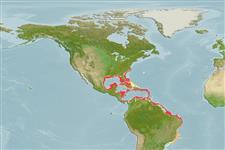Demospongiae |
Suberitida |
Halichondriidae
Environment: milieu / climate zone / depth range / distribution range
Ecology
Reef-associated; brackish; depth range 1 - 177 m (Ref. 108813). Tropical; 25°C - 33°C (Ref. 86836)
Western Central Atlantic.
Length at first maturity / Size / Weight / Age
Maturity: Lm ? range ? - ? cm
Massive-amorphous to lobate, and fleshy. The surface varies from smooth, wrinkled, to having fistules-like projections: 0.5 cm wide; 0.5 - 1 cm long. Compressible and a clear detachable skin is present (Ref. 415).
Common on mangrove roots, on bottom of mangrove creeks, and growing on peat banks (Ref. 415). Also known from coral reefs and rocky bottoms (Ref. 83912).
Life cycle and mating behavior
Maturity | Reproduction | Spawning | Eggs | Fecundity | Larvae
Members of the class Demospongiae are hermaphroditic. Life cycle: The zygote develops into parenchymella larva (free-swimming) before settling down on a substrate where it grows into a young sponge.
Collin, R., M.C. Díaz, J. Norenburg, R.M. Rocha, J.A. Sánchez, M. Schulze, A. Schwartz and A. Valdés. 2005. (Ref. 415)
IUCN Red List Status (Ref. 130435)
CITES status (Ref. 108899)
Not Evaluated
Not Evaluated
Threat to humans
Human uses
| FishSource |
Tools
More information
Age/SizeGrowthLength-weightLength-lengthMorphologyLarvaeAbundance
Internet sources
Estimates based on models
Preferred temperature
(Ref.
115969): 22.8 - 28, mean 26.5 (based on 220 cells).
Price category
Unknown.
